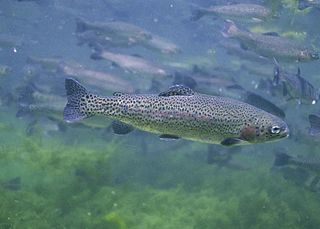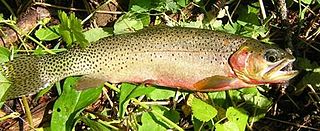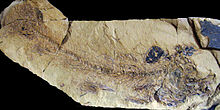
Actinopterygii, members of which are known as ray-finned fish or actinopterygians, is a class of bony fish that comprise over 50% of living vertebrate species. They are so called because of their lightly built fins made of webbings of skin supported by radially extended thin bony spines called lepidotrichia, as opposed to the bulkier, fleshy lobed fins of the sister class Sarcopterygii. Resembling folding fans, the actinopterygian fins can easily change shape and wetted area, providing superior thrust-to-weight ratios per movement compared to sarcopterygian and chondrichthyian fins. The fin rays attach directly to the proximal or basal skeletal elements, the radials, which represent the articulation between these fins and the internal skeleton.

Salmon is the common name for several commercially important species of euryhaline ray-finned fish from the genera Salmo and Oncorhynchus of the family Salmonidae, native to tributaries of the North Atlantic (Salmo) and North Pacific (Oncorhynchus) basins. Other closely related fish in the same family include trout, char, grayling, whitefish, lenok and taimen, all coldwater fish of the subarctic and cooler temperate regions with some sporadic endorheic populations in Central Asia.

Trout is a generic common name for numerous species of carnivorous freshwater ray-finned fishes belonging to the genera Oncorhynchus, Salmo and Salvelinus, all of which are members of the subfamily Salmoninae in the family Salmonidae. The word trout is also used for some similar-shaped but non-salmonid fish, such as the spotted seatrout/speckled trout.

The Osmeriformes are an order of ray-finned fish that includes the true or freshwater smelts and allies, such as the galaxiids and noodlefishes; they are also collectively called osmeriforms. They belong to the teleost superorder Protacanthopterygii, which also includes pike and salmon, among others. The order's name means "smelt-shaped", from Osmerus + the standard fish order suffix "-formes". It ultimately derives from Ancient Greek osmé + Latin forma, the former in reference to the characteristic aroma of the flesh of Osmerus.
Siberian taimen, also known as the common taimen, Siberian giant trout or Siberian salmon, is a species of salmon-like ray-finned fish from the genus Hucho in the family Salmonidae. These fish are found in rivers in Siberia and adjacent regions, and are harvested throughout the year.

The rainbow trout is a species of trout native to cold-water tributaries of the Pacific Ocean in Asia and North America. The steelhead is an anadromous (sea-run) form of the coastal rainbow trout(O. m. irideus) or Columbia River redband trout (O. m. gairdneri) that usually returns to freshwater to spawn after living two to three years in the ocean. Freshwater forms that have been introduced into the Great Lakes and migrate into tributaries to spawn are also called steelhead.

Salmo is a genus of ray-finned fish from the subfamily Salmoninae of family Salmonidae, and is part of the tribe Salmonini along with the sister genera Salvelinus and Salvethymus. Almost all Salmo species are native only in the Old World, the only exception being the Atlantic salmon, which is also naturally found across the North Atlantic in eastern North America.

The Apache trout or Arizona trout, Oncorhynchus apache, is a species of freshwater fish in the salmon family of order Salmoniformes. It is one of the Pacific trouts.

Pink salmon or humpback salmon is a species of euryhaline ray-finned fish in the family Salmonidae. It is the type species of the genus Oncorhynchus, and is the smallest and most abundant of the seven officially recognized species of salmon. The species' scientific name is based on the Russian common name for this species gorbúša (горбуша), which literally means humpie.

Oncorhynchus is a genus of ray-finned fish in the subfamily Salmoninae of the family Salmonidae, native to coldwater tributaries of the North Pacific basin. The genus contains twelve extant species, namely six species of Pacific salmon and six species of Pacific trout, all of which are migratory mid-level predatory fish that display natal homing and semelparity.

Hucho is a genus of large piscivorous salmonid fish known as taimens, and is closely related to Pacific trout and lenoks. Native to the cold rivers and other freshwater habitats in Eurasia, they are threatened by overfishing and habitat loss.

The westslope cutthroat trout, also known as the black-spotted trout, common cutthroat trout and red-throated trout is a subspecies of the cutthroat trout and is a freshwater fish in the salmon family of order Salmoniformes. The cutthroat is the Montana state fish. This subspecies is a species of concern in its Montana and British Columbia ranges and is considered threatened in its native range in Alberta.

Eosalmo is an extinct genus of ancient salmonid that lived during the Eocene epoch.

Lenoks, otherwise known as Asiatic trout or Manchurian trout, are salmonid fish of the genus Brachymystax, native to rivers and lakes in Mongolia, Kazakhstan, wider Siberia, Northern China and Korea.

Brachymystax lenok, the sharp-snouted lenok, is a salmonid fish distributed in rivers and lakes in northeastern Asia. It formerly included the blunt-snouted lenok, but recent authorities typically treat the latter as a separate species, B. tumensis, based on differences in morphology and genetics.

Diseases and parasites in salmon, trout and other salmon-like fishes of the family Salmonidae are also found in other fish species. The life cycle of many salmonids is anadromous, so such fish are exposed to parasites in fresh water, brackish water and saline water.
The Baja California rainbow trout or San Pedro Martir trout or Nelson's trout is a localized subspecies of the rainbow trout, a freshwater fish in the family Salmonidae.

Brachymystax tumensis, commonly known as the blunt-snouted lenok or Tumen lenok, is a salmonid fish distributed in rivers and lakes in Eastern Asia. It was formerly included in the more widespread species Brachymystax lenok, but more recent research based on differences in morphology and genetics have justified a distinction of the two species.

Salvelinus alpinus erythrinus, also known as Baikal charr or davatchan, is a subspecies of freshwater fish in the salmon family. It is endemic to the mountains north of Lake Baikal in the Russian Far East. The fish is edible and it is reported that the population of the species shrunk rapidly over the recent years due to over-fishing.


















